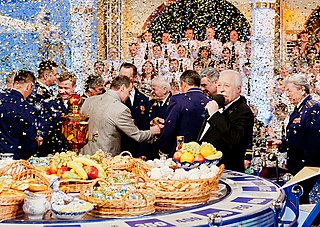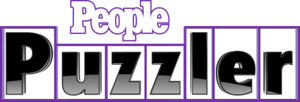Who Wants to Be a Millionaire? is an international television game show franchise of British origin, created by David Briggs, Mike Whitehill and Steven Knight. In its format, currently owned and licensed by Sony Pictures Television, contestants tackle a series of multiple-choice questions to win large cash prizes in a format that twists on many game show genre conventions – only one contestant plays at a time, similar to radio quizzes; contestants are given the question before deciding whether to answer, and have no time limit to answer questions; and the amount offered increases as they tackle questions that become increasingly difficult. The maximum cash prize offered in most versions of the format is an aspirational value in local currency, such as £1 million in the UK or ₹75 million in India.
In the United States, Standards and Practices is the name traditionally given to the department at a television network which is responsible for the moral, ethical, and legal implications of the program that the network airs. Standards and Practices also ensures fairness on televised game shows, in which they are the adjunct to the judges at the production company level. They also have the power to reprimand and to recommend the termination of television network stars and employees for violations of standards and practices.

Get the Picture is a children's game show that aired from March 18 to December 6, 1991, with repeats until March 13, 1993 on Nickelodeon. Hosted by Mike O'Malley, the show featured two teams answering questions and playing games for the opportunity to guess a hidden picture on a giant screen made up of 16 smaller screens. The show was recorded at Nickelodeon Studios in Universal Studios, Orlando, Florida. The program's theme music and game music was composed by Dan Vitco and Mark Schultz, and produced by Schultz. Its tagline is The Great Frame Game.

The $1,000,000 Chance of a Lifetime is an American game show which offered a $1 million (annuitized) grand prize to winning contestants. The show aired in syndication from January 6, 1986, until May 22, 1987. The show was hosted by Jim Lange, and he was joined by Karen Thomas as co-host during the second season. Mark Summers was the show's announcer for the first few weeks and Johnny Gilbert announced the remainder of the series. The show was produced by XPTLA, Inc., and distributed by Lorimar-Telepictures.
BrainTeaser was a British game show based on the original Dutch format of Puzzeltijd. The show was broadcast live, with phone-in viewer puzzles being announced and played during the show in addition to the studio game. During its run from 5 August 2002 to 7 March 2007, it aired on Five Mondays to Fridays, usually for an hour around lunchtime, and was fronted by various presenters rotating with one another. Beginning in August 2005, a version of the show that exclusively focused on viewer participation was broadcast in a four-hour long block on YooPlay TV every day after the Five broadcast, as part of a thirteen-week trial.

Game Ka Na Ba?, formerly Pilipinas Game Ka Na Ba is a Philippine game show created by ABS-CBN Studios. The main goal of the game is to win 2 million pesos by answering trivia questions.

Catchphrase is a British game show based on the short-lived American game show of the same name. It originally aired in the United Kingdom between 12 January 1986 and 23 April 2004. A revival premiered on ITV1 on 7 April 2013 and is still running as of 2024.
Pictionary is an American television game show which aired in syndication during the 1997–1998 season. The game was based on the board game of the same name where contestants guessed words and phrases based on drawings. Alan Thicke hosted the show with Joe Cipriano announcing. The series was a production of Kline and Friends and was distributed by Worldvision Enterprises.
Wheel of Fortune is an Australian television game show produced by Grundy Television until 2006, and CBS Studios International in 2008. The program aired on the Seven Network from 1981 to 2004 and January to July 2006, aired at 5:00pm from 1981 to 1989 and from 2004 to 2006 and at 5:30pm from 1989 to 2003, and is mostly based on the same general format as the original American version of the program.

The Mint was a live, late night, interactive quiz show with celebrity guests and live studio contestants filmed on a large extravagant set designed to look like the inside of a mansion. The programme, which was dogged by criticism that its questions were ambiguous and arbitrary, aired on ITV and ITV2, Sunday to Wednesday. On 26 February 2007, ITV announced that The Mint would return to screens later in 2007, however an announcement on 12 September 2007 confirmed that the show, along with similar late night phone ins, would not be returning.

The Field of Wonders is a Soviet, later Russian adaptation of the U.S. game show Wheel of Fortune produced by VID, provided with elements of Russian culture and hosted by Leonid Yakubovich.
Quizmania is an Australian phone-in quiz show, based on the British program of the same name, and broadcast on the Nine Network in the late night time slot (post-midnight). The show was produced from Nine's Richmond studios in Melbourne. Its main director was Rick Maslan.

¡Allá tú! is the Spanish version of Deal or No Deal. It was initially broadcast by Telecinco between 2004 and 2008 and later changed to sister channel Cuatro for a comeback in 2011, before returning to Telecinco in 2023.
Power of 10 is an international Sony Pictures Television game show format featuring contestants predicting how a cross-section of local people from the host broadcaster's country responded to questions covering a wide variety of topics in polls conducted by the broadcaster and production company.
Brain Battle was a Canadian interactive game show, which aired weekdays on Global. The show premiered on March 26, 2007, and aired a total of 356 episodes as of its series finale on August 4, 2008.

Don't Forget the Lyrics! is an American television game show in which contestants compete to win $1 million by correctly recalling song lyrics from a variety of genres. The program originally aired on Fox from July 11, 2007, to June 19, 2009, hosted by Wayne Brady and produced by RDF USA, part of RDF Media. The premiere of the show prompted NBC to move up the premiere of their similar game show, The Singing Bee.

Quizmania is a British interactive game show. The show was devised by Chuck Thomas, Debbie King, and Simone Thorogood and produced by FremantleMedia for Information TV and ITV. Similar to other premium-line call-in shows, viewers on the TV version of Quizmania were encouraged to phone a premium-rate number in order to provide an answer to a quiz question.
Gefragt – Gejagt (Asked—Chased) is a quiz show that has been broadcast on German television since 2012. It is the German adaptation of ITV's show The Chase.

People Puzzler is an American television game show hosted by Leah Remini and broadcast by Game Show Network as well as in syndication. It premiered on January 18, 2021. The show is inspired by the celebrity and pop-culture themed crosswords in People magazine.










